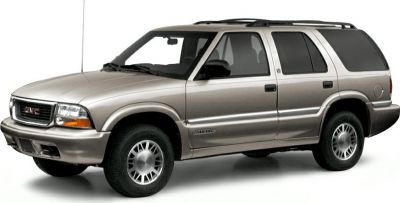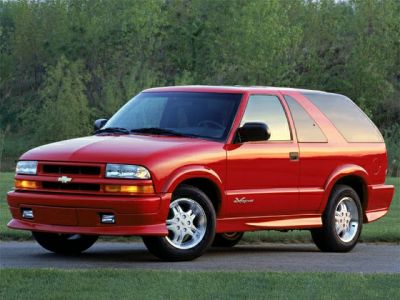 1995 Chevrolet Blazer II Dimensions, Size & Specs
1995 Chevrolet Blazer II Dimensions, Size & Specs
Measurements of the 1995 Chevrolet Blazer II, engineered for optimal performance and comfort
| Dimensions | |
|---|---|
| Length: | 4420-4602 mm174.0-181.2 in14.5-15.1 ft |
| Width: | 1661-1772 mm65.4-69.8 in5.4-5.8 ft |
| Height: | 1593-1702 mm62.7-67.0 in5.2-5.6 ft |
| Trunk Capacity: | 845-1056 liter29.8-37.3 cu ft |
| Trunk Capacity (Max): | 1717-2098 liter60.6-74.1 cu ft |
| Weight Specifications | |
| Curb Weight: | 1542-1860 kg3400-4101 lbs |
| Maximal permitted Weight: | 2170-2440 kg4784-5379 lbs |
| Tire Specifications | |
| Tire Sizes: |
|
The Chevrolet Blazer II, produced between 1994 and 1998, represents a mid-size SUV that combines practical dimensions with versatile capacity, making it a popular choice among SUV enthusiasts in the mid-1990s. This generation of the Blazer features variable lengths ranging from 4420 mm to 4602 mm (174.0 to 181.2 inches), allowing a slightly flexible footprint depending on model variants or optional equipment. Width measurements span from 1661 mm to 1772 mm (65.4 to 69.7 inches), while height varies between 1593 mm and 1702 mm (62.7 to 67.0 inches), showcasing a compact but commanding presence typical of SUVs in its category.
Weight specifications for the Blazer II reveal a curb weight ranging from 1542 kg up to 1860 kg (3,400 to 4,100 pounds), supporting a maximum gross weight capacity between 2170 kg and 2440 kg (4,783 to 5,380 pounds). These figures indicate the vehicle’s capacity to handle diverse driving conditions, including carrying passengers and cargo effectively. Speaking of cargo, the luggage capacity is impressive with a range of 845 to 1056 liters (29.8 to 37.3 cubic feet) under standard seating arrangements. When the rear seats are folded down, this capacity significantly increases to between 1717 and 2098 liters (60.6 to 74.1 cubic feet), allowing for enhanced cargo flexibility.
The Chevrolet Blazer II of this era was typically equipped with tire sizes such as 235/75 R15, 235/70 R15, 205/75 R15 P, and 205/75 R15 S. These tire options provide a balance of on-road comfort and off-road capability, fitting the SUV’s image as a versatile utility vehicle.
Overall, the Chevrolet Blazer II is a well-rounded, moderately sized SUV designed to meet the needs of families and adventurers alike during its production run in the mid to late 1990s. Its size and weight dimensions offer a mix of maneuverability and interior space, making it a relevant comparison point among SUVs of its time and a practical vehicle for a wide variety of uses.
Discover the standout features that make the 1995 Chevrolet Blazer II a leader in its class
Have a question? Please check our knowledgebase first.
The Chevrolet Blazer II produced from 1994 to 1998 has a length range between 4420 mm and 4602 mm. In imperial units, this translates to approximately 174 inches to 181.1 inches (or about 14.5 feet to 15.1 feet). The variation in length is mainly due to different trims or optional equipment that slightly affected overall vehicle dimensions. This length positions it as a mid-size SUV, offering a balance between maneuverability and interior space.
The width of the Chevrolet Blazer II ranges from 1661 mm to 1772 mm, depending on the specific version or wheel setup. In imperial units, this translates to approximately 65.4 inches to 69.7 inches (around 5.45 feet to 5.8 feet). The variation in width allows for different tire and suspension setups, which can impact off-road performance and interior shoulder room. This width is typical for SUVs from the mid-1990s.
The height of the Chevrolet Blazer II varies between 1593 mm and 1702 mm, which equals approximately 62.7 inches to 67 inches, or 5.23 feet to 5.58 feet. This variance is influenced by factors such as trim level, suspension setup, and optional features like roof racks or lift kits. The height provides a commanding view of the road typical for SUVs of its class, as well as sufficient ground clearance for mild off-roading.
The curb weight of the Chevrolet Blazer II ranges from 1542 kg to 1860 kg. In pounds, this is roughly between 3401 lbs and 4101 lbs. Curb weight refers to the total weight of the vehicle with standard equipment, all necessary operating consumables like oil and fuel, but without passengers or cargo. This weight range reflects the model variation; heavier trims may have more equipment or four-wheel-drive systems that contribute to added mass.
The maximum permissible weight for the Chevrolet Blazer II ranges from 2170 kg to 2440 kg, which converts to approximately 4785 lbs to 5381 lbs. This figure includes the curb weight plus the weight of passengers, cargo, and any additional load. It reflects the maximum safe operating weight for the vehicle, which is essential for towing, carrying capacity, and overall safety to avoid overloading the SUV beyond its design limits.
With the rear seats in place, the Chevrolet Blazer II offers a luggage capacity ranging between 845 liters and 1056 liters (approximately 29.8 to 37.3 cubic feet). When the rear seats are folded down, this expands significantly to between 1717 liters and 2098 liters, which converts to about 60.6 to 74.1 cubic feet. This flexibility allows owners to accommodate larger loads or increase passenger comfort by choosing between passenger and cargo space.
Yes, the Chevrolet Blazer II generally fits into a standard residential garage. Residential garages usually provide a minimum height clearance of around 2.13 meters (84 inches or 7 feet) and width of at least 2.44 meters (96 inches or 8 feet). Given the Blazer II's maximum height is approximately 1.7 meters (67 inches or 5.58 feet) and width tops at 1.77 meters (69.7 inches or 5.8 feet), it comfortably fits within these dimensions. However, tight garages or those with storage items may require careful maneuvering.
The Chevrolet Blazer II succeeded the original K5 Blazer, bringing a more modern SUV design typical of the mid-1990s. Compared to its predecessor, the Blazer II is slightly smaller and lighter, with lengths generally ranging from 4420 mm to 4602 mm, whereas the K5 was longer. The newer Blazer also featured updated styling, better fuel efficiency, and improved interior comfort. Width and height measurements reflect a design that favors road usability and family friendliness over the rugged off-road appearance of its predecessor.
In the mid-1990s SUV category, the Chevrolet Blazer II was a competitive mid-size SUV. Its length (4420 to 4602 mm or 174 to 181 inches) and width (1661 to 1772 mm or 65 to 70 inches) were comparable with rivals such as the Ford Explorer and Jeep Grand Cherokee. Cargo space was generous, with up to around 2098 liters (74.1 cubic feet) when rear seats were folded, which was competitive for its class. This made the Blazer II a practical choice for families looking for a versatile SUV.
The Chevrolet Blazer II came equipped with several tire sizes including 235/75 R15, 235/70 R15, 205/75 R15 P, and 205/75 R15 S. The common 15-inch rim diameter helped balance ride comfort and ground clearance. The 235 mm wide tires offered improved traction and stability, especially for off-road driving and towing, while the 205 mm wide options favored fuel economy and a smoother ride on paved roads. Tire choice impacts handling, grip, and overall driving experience.
Discover similar sized cars.

| Production: | 1994-2001 |
|---|---|
| Model Year: | 1995 |
| Length: | 4503 mm177.3 in |
| Width: | 1722 mm67.8 in |
| Height: | 1648 mm64.9 in |

| Production: | 1993-1997 |
|---|---|
| Model Year: | 1993 |
| Length: | 4480 mm176.4 in |
| Width: | 1690 mm66.5 in |
| Height: | 1660 mm65.4 in |

| Production: | 1998-2005 |
|---|---|
| Model Year: | 1999 |
| Length: | 4491 mm176.8 in |
| Width: | 1722 mm67.8 in |
| Height: | 1638-1648 mm64.5-64.9 in |

| Production: | 1989-2000 |
|---|---|
| Model Year: | 1990 |
| Length: | 4480 mm176.4 in |
| Width: | 1690 mm66.5 in |
| Height: | 1660 mm65.4 in |
